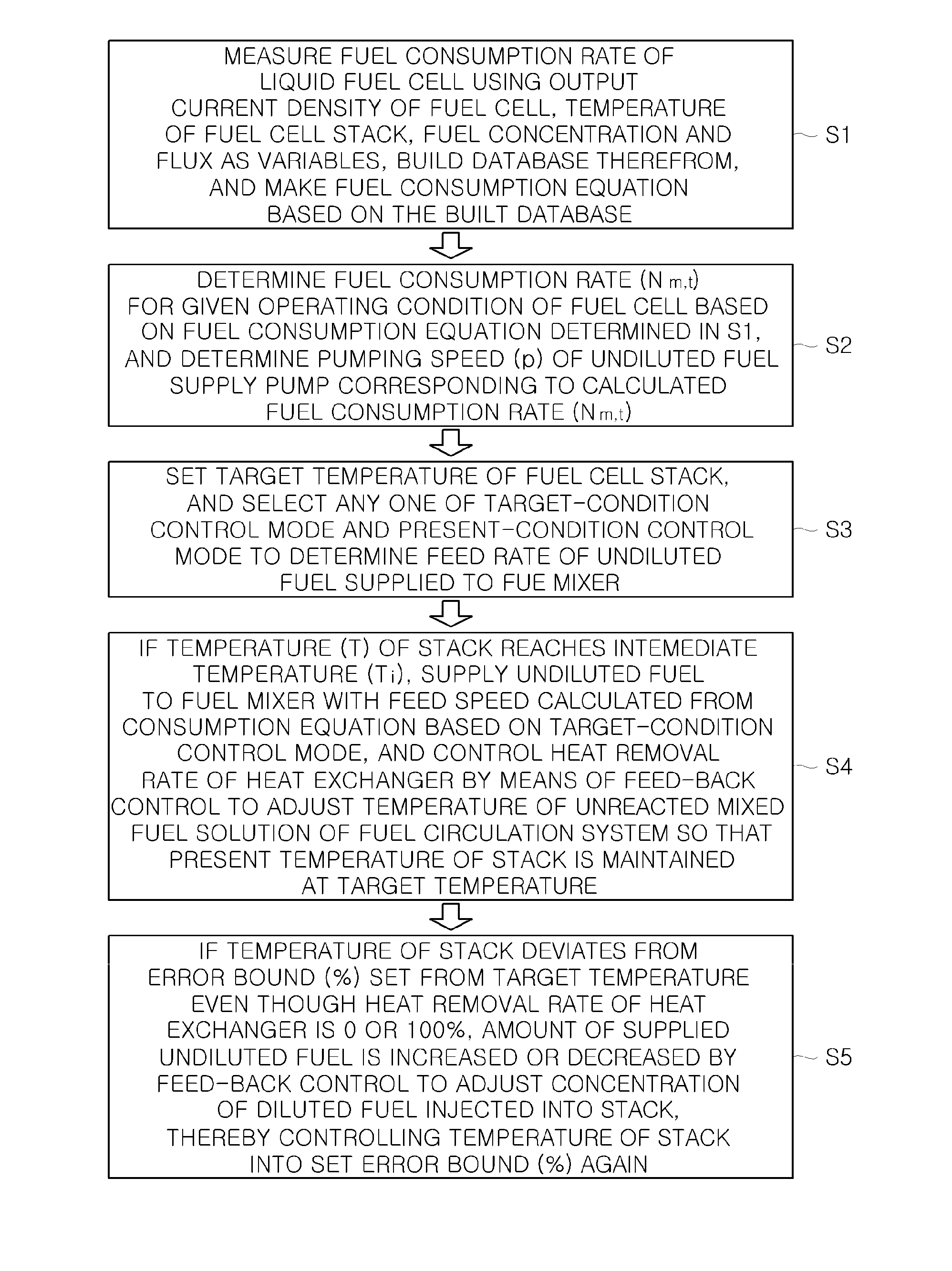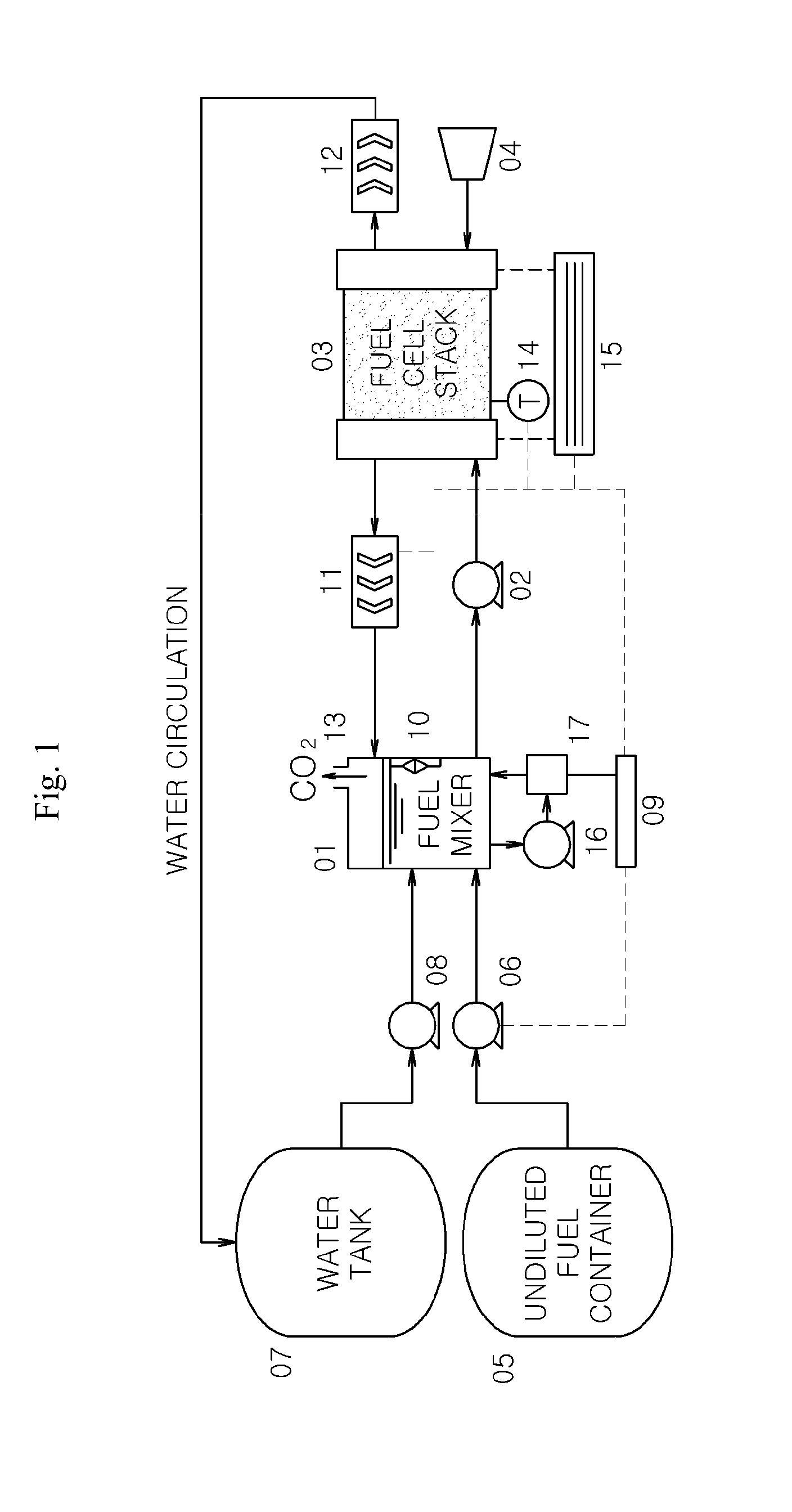In other words, when a
liquid fuel used in the liquid fuel cell is supplied with a
high concentration, a
crossover phenomenon may occur so that the liquid fuel moves from the
anode to the
cathode through the
electrolyte membrane, and to this end the fuel
crossover may cause various problems such as a performance deterioration of the fuel cell, a decrease in energy efficiency of the fuel, etc.
If the fuel concentration is higher than an optimal fuel concentration of the fuel cell, the amount of fuel
crossover from the
anode to the
cathode through the
electrolyte membrane may increase, which in turn may lower the performance.
To the contrary, if a fuel with a low concentration is supplied to the
anode of the fuel cell stack, a fuel deficiency may occur at the anode, which may decrease performance of the fuel cell.
Meanwhile, if a fuel is stored or used in a diluted state inside the liquid fuel cell apparatus, or if a fuel which has been used once and is still containing an unreacted fuel is discharged out and wasted, the energy efficiency of the fuel cell apparatus deteriorates and the
advantage as a portable high-density power source may be lost.
For this reason, the conventional concentration control method makes the fuel
cell system more complicated and bigger, and the parasitic power losses due to the corresponding sensor and the pump increases, which deteriorate the energy efficiency of the fuel
cell system.
Further, concentration sensors presently available in the art are expensive and have great measurement errors and
short life spans.
Therefore, if the concentration sensors are applied to the fuel
cell system, the fuel cell
system has an increased production cost and lower safety, and therefore may not maintain price and quality competitiveness as a
portable power source.
However, as time goes on, the reproducibility and stability of measurement is lowered since the catalyst in the sensor loses its activity.
However, according to an observation by the inventors of the present disclosure, this method takes much time to increase a concentration to a
target concentration since it does not use a feed-back function and a concentration control method for a startup of a liquid fuel cell in combination.
In addition, the rate of change of diluted fuel concentration is slow, and the ability to react to a change of outside environments is not provided.
However, according to an observation by the inventors of the present disclosure, this method has a
slow response due to a
delay time for periodic observing, does not ensure accurate concentration control, and has an increased error in concentration control if the performance of the fuel cell deteriorates over time due to a long-term operation.
However, according to an observation by the inventors of the present disclosure, this method also takes relatively long time for controlling a concentration and operating a fuel cell in a
normal state, and a temperature and a
voltage of the fuel cell stack and a concentration of the fuel continuously vary.
In addition, when the performance of the fuel cell deteriorates over time, the concentration
control error increases.
Further, while the above methods control a fuel concentration in a
normal state operation of a liquid fuel cell without using a sensor, a method of controlling a fuel concentration in a startup of a liquid fuel cell or controlling an output
current density is not being developed.
However, according to an observation by the inventors of the present disclosure, this method controls only a fuel concentration in the startup period, and a method for controlling an output
current density in the period is not proposed.
In addition, since a concentration sensor is used, this method is fundamentally different from a concentration control method not using a sensor, and the variation of ambient temperature which may occur in operation is not considered.
If the ambient temperature increases in operation, a water shortage phenomenon in which water in the water tank is exhausted may occur.
If the ambient temperature decreases on the contrary, the heat loss of the stack may increase, which reduces the efficiency of the fuel and the
system.
Therefore, the fuel cell apparatus may have a simple and small design, which reduces the power consumed for operation and lowers the apparatus price.
 Login to View More
Login to View More  Login to View More
Login to View More 


